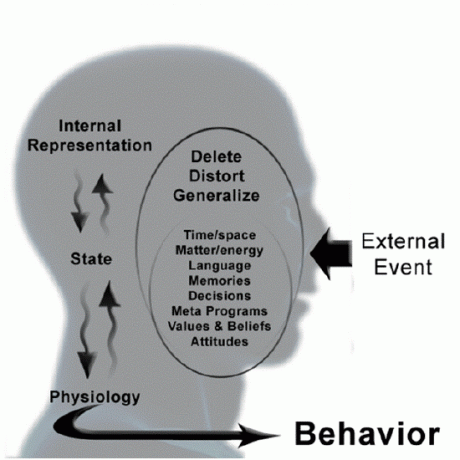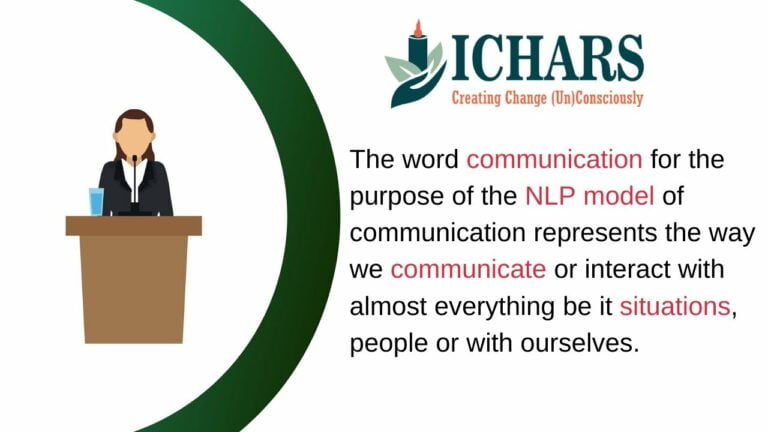Welcome to an insightful exploration of the NLP model of communication, a comprehensive framework developed by Richard Bandler and John Grinder. In this guide, we delve into the intricate dynamics of how we receive, process, and respond to information, unraveling the complexities of human interaction and perception.
Defining Communication
Communication, for the purpose of this model represents the way we communicate or interact with almost everything be it situations, people or with ourselves.
What is the NLP model of communication?
The NLP Communication model was developed by Richard Bandler and John Grinder. It explains how we receive information that comes from the outside world, how we process it and how it influences the way we communicate/respond to others.
But before we get into the model, let us do a small experiment.
Take a moment and look around. Notice where you are and what are the different things that are happening around you.
- Are there people around or not?
- Are there other sounds that you are able to notice?
- If you are in a closed space, i.e. a room or a hall, can notice the colour of the walls and of the ceiling?
- While you are listening to my voice, can you notice the pauses and the modulation of the voice?
- While looking at the screen, can you notice all the things present on the screen?
Notice how we are a part of a world in which many things happen simultaneously. The amount of information that we receive on a moment by moment basis is humongous. We use our senses to observe this information i.e. to observe this world.

Which are these senses?
- Visual as in what we see,
- Auditory i.e. what we hear,
- Kinesthetic i.e. touch,
- Olfactory i.e. smell and
- Gustatory i.e. taste
Since we use these senses to receive and observe information, anything that our senses are not able to grasp we are not able to observe.
Wait a minute, why would our senses not be able to grasp certain things?
Simply because of certain constraints that are related to our nervous system which controls and coordinates our 5 senses.
NLP model of communication: Neurological Constraints
Each of these senses are limited neurologically.
For example, our hearing sense. Bats create sound, but we cannot hear them as these are ultra-sonic sounds i.e sounds at frequencies higher then what we as humans are capable of hearing.
It is these neurological constraints that become the primary reason for our inability to observe reality completely.
Since neurological constraints prevent us from observing the world for what it is and limit the information that we can perceive, in order to make sense of the world and to navigate through the world effectively, we make use of social and individual constraints.
NLP model of communication: Social and Individual Constraints
As a result of these constraints, we create certain filters which help us make sense of this world and prepare for different situations that we face in it.
NLP model of communication: Primary Filters

These filters include:
- Generalisations
- Deletions
- Distortions
What are Generalisations?
Generalisation is the process of taking something specific and applying it more broadly.
For e.g. I have come across a couple of politicians who are corrupt and based on this experience I generalise that all politicians are corrupt.
Let us take another example. Let’s say I went for a few interviews and did not get selected. I may create a generalisation that I always fail in interviews. Later the generalisation may become broader I may start believing that I fail at everything.
Now that I have given you a couple of examples of generalisation, I am sure you can think of a couple of examples. Remember generalisation include words like always, every time, everyone, no one, never and so. Make a note of at least three generalisations in your workbook. It may be a good idea to pause this video while you write the generalisation down.
Once we create generalisations, we organise our life around it and therefore try to hold on to them even when contrary evidence is available. So in order to negate any contrary evidence our system deletes or distorts the evidence in a way that we either don’t notice the evidence or interpret it in a way that the new interpretation is in sync with the generalisation.
Have you been able to notice the similarities between the role of critical filter in the TOM and of generalisation, deletion and distortion that we have discussed here? Let us quickly define deletion and distortion before going ahead:
Deletion is a process by which we selectively pay attention to certain dimensions of our experience and exclude others. For example, when we are watching a movie and a small child is crying in the theatre, a lot of us are able to delete the sounds of the child and focus on the movie while others delete the sounds of the movie and focus on the crying of the child.
Coming to Distortion, distortion is the process by which we alter our perceptions, changing our experience of sensory input. Generally, these distortions are made to give an interpretation of the information received so that the interpreted information is in sync with our generalisations or beliefs. So if I generalise that I am not capable of getting a job, when I do get a job, I may interpret, I was just lucky. This interpretation allows me to stick to my generalisation that I am not capable of.
Now before we go ahead, let us quickly summarise what we have covered till here.
We create an internal representation of the world. This internal representation is like a map that we use to understand and navigate the world.
Given that the information we have used to create this map is incomplete and distorted, will the map be the same as the world we are trying to represent?
No, not exactly the same. It can be similar depending upon the degree of distortion and deletion, but not the same. Right?
Why is this important to understand?
It is important to understand because a map or an internal representation is our subjective reality which may, at times, be very different from the objective reality.
NLP model of communication: Subjective vs Objective Reality

When people discuss their problems, they generally think they are talking about the objective reality but what they really are talking about is their subjective reality. In other words, most problems that we think we have are not really a part of reality but simply a part of our map.
If the map is distorted, isn’t there a high possibility that my interpretation that there is a problem is also distorted?
It is….. right?
Let us take an example to understand this, let’s say I believe in a generalisation that no one likes me.
Now one day I saw a friend walking on a road. I called out his name. As I took his name I saw him begin to walk faster away from me. What I did not see was that he was wearing an earphone (so wasn’t able to hear my voice) and was trying to catch a bus (so started walking faster). Based on what I observed along with my generalisation that people don’t like me, I interpreted this as him trying to ignore me.
For many days I kept wondering, why did he avoid me? Did I do something that made him angry or has he done something because of which he couldn’t face me?
Though I thought there was a problem the problem was only in my map and not in reality.
NLP model of communication: Mental and Physical State
It is important to remember that the filters and the existing internal representation determine how we perceive things which in turn influences our mental state i.e. the way we feel. This mental state influences our physical state i.e. our physiology which in turn influences our response behaviours.
NLP communication model: Self-Fulfilling Prophecy
Taking it a step forward, our final results are a result of the behaviours that we engage in consistently over a period of time. In most cases, our results will either be in sync with our generalisations & beliefs or we will distort them to bring them in sync with our generalisations & beliefs. This is called a self-fulfilling prophecy.
NLP model of communication: Application in therapy and Coaching
By now, I am sure you may have already started noticing a similar theme that runs across the various models we have covered in this section. Be it the SOR Model, the ABC Model, the theory of mind and the NLP communication model.
If you would like to learn more about these models and their application in Coaching, do check out the Cognitive Hypnotic Coaching™ program. If you are a psychologist and are interested in exploring the application of these models in therapy, you would find the internationally accredited course on Cognitive Hypnotic Psychotherapy™ very impressive.
Now that you understand these models, in the coming week I would like you to do a small experiment.
Whenever you think there is a problem, just ask yourself “Is this problem really real or is it just a part of my map?”
And you may be surprised to know that just this one question can make a lot of positive difference in your life.

